大数据英文版PPT模板
- 格式:pptx
- 大小:10.72 MB
- 文档页数:27


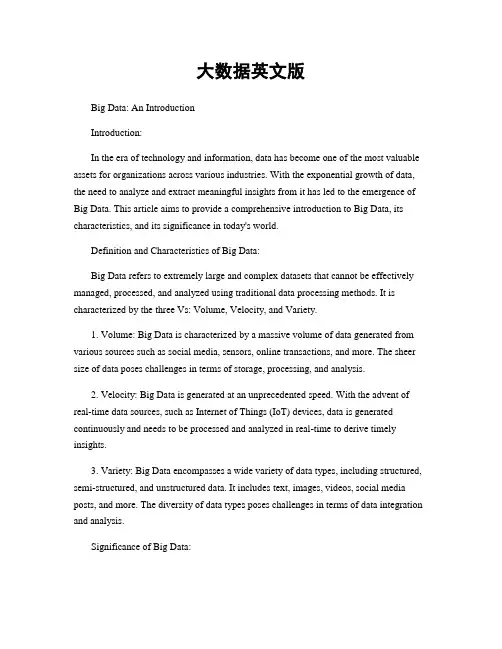
大数据英文版Big Data: An IntroductionIntroduction:In the era of technology and information, data has become one of the most valuable assets for organizations across various industries. With the exponential growth of data, the need to analyze and extract meaningful insights from it has led to the emergence of Big Data. This article aims to provide a comprehensive introduction to Big Data, its characteristics, and its significance in today's world.Definition and Characteristics of Big Data:Big Data refers to extremely large and complex datasets that cannot be effectively managed, processed, and analyzed using traditional data processing methods. It is characterized by the three Vs: Volume, Velocity, and Variety.1. Volume: Big Data is characterized by a massive volume of data generated from various sources such as social media, sensors, online transactions, and more. The sheer size of data poses challenges in terms of storage, processing, and analysis.2. Velocity: Big Data is generated at an unprecedented speed. With the advent of real-time data sources, such as Internet of Things (IoT) devices, data is generated continuously and needs to be processed and analyzed in real-time to derive timely insights.3. Variety: Big Data encompasses a wide variety of data types, including structured, semi-structured, and unstructured data. It includes text, images, videos, social media posts, and more. The diversity of data types poses challenges in terms of data integration and analysis.Significance of Big Data:Big Data has revolutionized the way organizations operate and make data-driven decisions. Its significance can be observed in various domains:1. Business Insights: Big Data analytics enables organizations to gain valuable insights into customer behavior, market trends, and preferences. This information helps businesses to personalize their products and services, improve customer satisfaction, and make informed business decisions.2. Healthcare: Big Data analytics has the potential to revolutionize healthcare by analyzing large volumes of patient data, identifying patterns, and predicting diseases. It can help in early detection, personalized treatment plans, and improving overall healthcare outcomes.3. Fraud Detection: Big Data analytics plays a crucial role in detecting fraudulent activities in various sectors, such as banking, insurance, and e-commerce. By analyzing large volumes of transactional data, anomalies can be identified, and fraud can be prevented.4. Smart Cities: Big Data analytics is instrumental in creating smart cities by analyzing data from various sources, such as sensors, social media, and traffic cameras. It helps in optimizing transportation systems, reducing energy consumption, and improving overall urban living.Challenges of Big Data:While Big Data offers numerous opportunities, it also presents several challenges that need to be addressed:1. Data Privacy and Security: With the increasing volume and variety of data, ensuring data privacy and security becomes a critical concern. Organizations need to implement robust security measures to protect sensitive data from unauthorized access and breaches.2. Data Quality: Big Data often contains noise, errors, and inconsistencies. Ensuring data quality is crucial for accurate analysis and decision-making. Data cleansing and validation processes need to be implemented to maintain data integrity.3. Infrastructure and Scalability: Managing and processing large volumes of data requires robust infrastructure and scalable systems. Organizations need to invest in technologies such as cloud computing and distributed computing frameworks to handle Big Data efficiently.4. Skills Gap: The field of Big Data requires specialized skills such as data analytics, data engineering, and machine learning. The shortage of skilled professionals poses a challenge in effectively utilizing Big Data for business benefits.Conclusion:Big Data has emerged as a game-changer in today's data-driven world. With its massive volume, high velocity, and diverse variety, Big Data presents both opportunities and challenges for organizations. By harnessing the power of Big Data analytics, organizations can gain valuable insights, make informed decisions, and unlock new avenues for growth and innovation. However, addressing the challenges associated with Big Data is crucial to ensure data privacy, quality, and scalability. As organizations continue to embrace Big Data, it is expected to reshape industries and drive the next wave of innovation.。

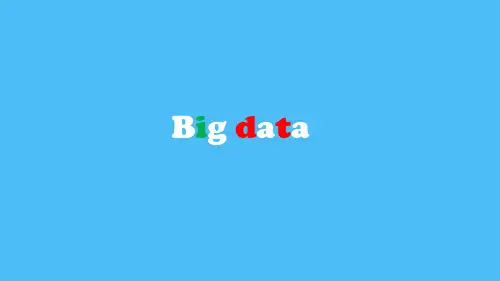

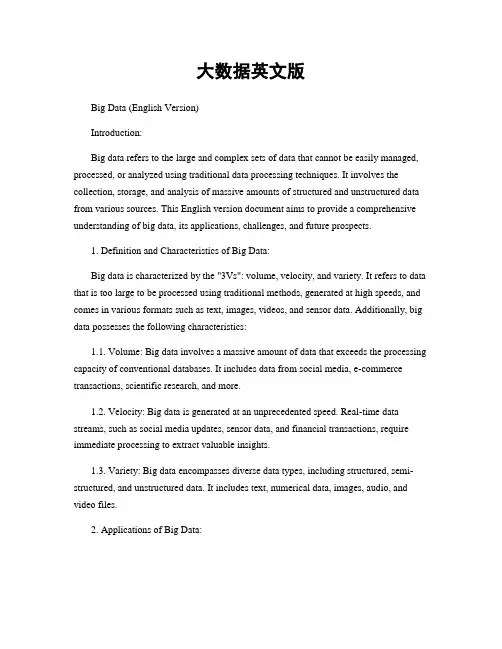
大数据英文版Big Data (English Version)Introduction:Big data refers to the large and complex sets of data that cannot be easily managed, processed, or analyzed using traditional data processing techniques. It involves the collection, storage, and analysis of massive amounts of structured and unstructured data from various sources. This English version document aims to provide a comprehensive understanding of big data, its applications, challenges, and future prospects.1. Definition and Characteristics of Big Data:Big data is characterized by the "3Vs": volume, velocity, and variety. It refers to data that is too large to be processed using traditional methods, generated at high speeds, and comes in various formats such as text, images, videos, and sensor data. Additionally, big data possesses the following characteristics:1.1. Volume: Big data involves a massive amount of data that exceeds the processing capacity of conventional databases. It includes data from social media, e-commerce transactions, scientific research, and more.1.2. Velocity: Big data is generated at an unprecedented speed. Real-time data streams, such as social media updates, sensor data, and financial transactions, require immediate processing to extract valuable insights.1.3. Variety: Big data encompasses diverse data types, including structured, semi-structured, and unstructured data. It includes text, numerical data, images, audio, and video files.2. Applications of Big Data:2.1. Business Analytics: Big data enables organizations to gain valuable insights into customer behavior, preferences, and market trends. It helps in making data-driven decisions, improving customer satisfaction, and optimizing business processes.2.2. Healthcare: Big data analytics can be used to analyze patient records, medical imaging, and genomic data. It aids in personalized medicine, disease prediction, and improving healthcare outcomes.2.3. Finance: Big data analytics helps financial institutions in fraud detection, risk assessment, and customer segmentation. It enables real-time monitoring of transactions and enhances security measures.2.4. Transportation: Big data is used to optimize traffic management, predict maintenance needs, and improve public transportation systems. It helps in reducing congestion, enhancing safety, and improving efficiency.2.5. Manufacturing: Big data analytics assists in optimizing production processes, predicting equipment failures, and improving supply chain management. It enables proactive maintenance, reduces downtime, and enhances overall productivity.3. Challenges of Big Data:Despite its numerous advantages, big data also presents several challenges that need to be addressed:3.1. Data Quality: Big data often contains errors, inconsistencies, and missing values. Ensuring data quality is crucial for accurate analysis and decision-making.3.2. Privacy and Security: Handling large volumes of sensitive data raises concerns about privacy and security. Safeguarding data from unauthorized access and ensuring compliance with regulations is essential.3.3. Scalability: Big data requires scalable infrastructure and technologies to handle the ever-increasing volume and velocity of data. Scaling up existing systems can be complex and costly.3.4. Data Integration: Combining and integrating data from various sources with different formats and structures can be challenging. Data integration techniques and tools need to be employed for effective analysis.4. Future Prospects:The future of big data holds immense potential for advancements in various fields. Some of the key areas of development include:4.1. Artificial Intelligence (AI): Big data fuels the development of AI algorithms and machine learning models. AI, in turn, enhances big data analytics capabilities, enabling better predictions and insights.4.2. Internet of Things (IoT): The proliferation of IoT devices generates vast amounts of data. Big data analytics helps in extracting meaningful information from IoT-generated data for improved decision-making.4.3. Cloud Computing: The scalability and flexibility of cloud computing make it an ideal platform for big data processing and storage. The integration of big data and cloud computing enables cost-effective and efficient data analysis.4.4. Data Governance: As big data continues to grow, the need for effective data governance becomes crucial. Establishing policies, procedures, and frameworks for data management and privacy protection will be a priority.Conclusion:Big data has revolutionized the way organizations analyze and leverage data for decision-making. Its applications span across various sectors, including business, healthcare, finance, transportation, and manufacturing. However, challenges related to data quality, privacy, scalability, and integration need to be addressed. The future prospects of big data are promising, with advancements in AI, IoT, cloud computing, and data governance. Embracing big data and harnessing its potential will undoubtedly drive innovation and transform industries globally.。

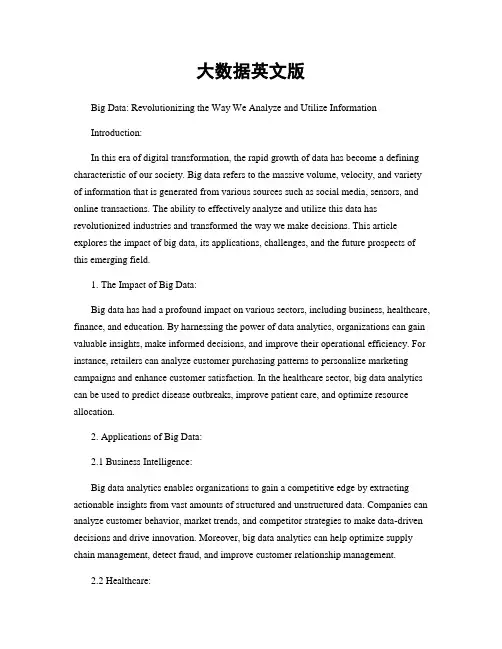
大数据英文版Big Data: Revolutionizing the Way We Analyze and Utilize InformationIntroduction:In this era of digital transformation, the rapid growth of data has become a defining characteristic of our society. Big data refers to the massive volume, velocity, and variety of information that is generated from various sources such as social media, sensors, and online transactions. The ability to effectively analyze and utilize this data has revolutionized industries and transformed the way we make decisions. This article explores the impact of big data, its applications, challenges, and the future prospects of this emerging field.1. The Impact of Big Data:Big data has had a profound impact on various sectors, including business, healthcare, finance, and education. By harnessing the power of data analytics, organizations can gain valuable insights, make informed decisions, and improve their operational efficiency. For instance, retailers can analyze customer purchasing patterns to personalize marketing campaigns and enhance customer satisfaction. In the healthcare sector, big data analytics can be used to predict disease outbreaks, improve patient care, and optimize resource allocation.2. Applications of Big Data:2.1 Business Intelligence:Big data analytics enables organizations to gain a competitive edge by extracting actionable insights from vast amounts of structured and unstructured data. Companies can analyze customer behavior, market trends, and competitor strategies to make data-driven decisions and drive innovation. Moreover, big data analytics can help optimize supply chain management, detect fraud, and improve customer relationship management.2.2 Healthcare:Big data has the potential to revolutionize healthcare by enabling personalized medicine, improving patient outcomes, and reducing costs. By analyzing electronic health records, genomic data, and real-time patient monitoring, healthcare providers can identify patterns, predict diseases, and develop targeted treatment plans. Additionally, big data analytics can enhance clinical research, facilitate drug discovery, and improve healthcare delivery.2.3 Finance:The finance industry heavily relies on big data analytics to detect fraudulent activities, assess creditworthiness, and optimize investment strategies. By analyzing large volumes of financial data, including market trends, customer transactions, and social media sentiment, financial institutions can make more accurate risk assessments and improve their decision-making processes. Furthermore, big data analytics can help identify potential market opportunities and enhance regulatory compliance.2.4 Education:Big data analytics is transforming the education sector by providing insights into student performance, learning patterns, and personalized learning experiences. By analyzing student data, educators can identify at-risk students, tailor instructional approaches, and develop targeted interventions. Moreover, big data analytics can facilitate adaptive learning platforms, improve curriculum design, and enable lifelong learning.3. Challenges of Big Data:While big data offers immense opportunities, it also presents several challenges that need to be addressed:3.1 Data Privacy and Security:The vast amount of data collected raises concerns about privacy and security. Organizations must ensure that data is stored securely, and appropriate measures aretaken to protect sensitive information. Additionally, regulations and policies need to be in place to safeguard individuals' privacy rights.3.2 Data Quality and Integration:Big data comes from various sources and in different formats, making it challenging to ensure data quality and integrate disparate datasets. Data cleansing and integration techniques are essential to ensure accurate and reliable analysis.3.3 Scalability and Infrastructure:The sheer volume and velocity of big data require robust infrastructure and scalable systems to store, process, and analyze the data in a timely manner. Organizations need to invest in advanced technologies and tools to handle the growing demands of big data analytics.4. Future Prospects of Big Data:The future of big data looks promising, with ongoing advancements in technology and increased adoption across industries. The emergence of artificial intelligence and machine learning algorithms will further enhance the capabilities of big data analytics. Additionally, the integration of big data with the Internet of Things (IoT) will generate new opportunities for data-driven decision-making and predictive analytics.Conclusion:Big data has revolutionized the way we analyze and utilize information, enabling organizations to gain valuable insights, make data-driven decisions, and drive innovation. Its applications span across various sectors, including business, healthcare, finance, and education. However, challenges such as data privacy, quality, and infrastructure need to be addressed to fully harness the potential of big data. With ongoing advancements and increased adoption, big data is set to play a pivotal role in shaping the future of industries and society as a whole.。
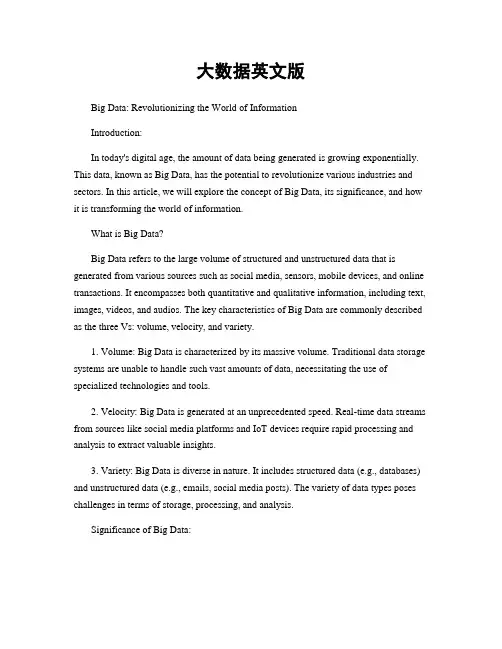
大数据英文版Big Data: Revolutionizing the World of InformationIntroduction:In today's digital age, the amount of data being generated is growing exponentially. This data, known as Big Data, has the potential to revolutionize various industries and sectors. In this article, we will explore the concept of Big Data, its significance, and how it is transforming the world of information.What is Big Data?Big Data refers to the large volume of structured and unstructured data that is generated from various sources such as social media, sensors, mobile devices, and online transactions. It encompasses both quantitative and qualitative information, including text, images, videos, and audios. The key characteristics of Big Data are commonly described as the three Vs: volume, velocity, and variety.1. Volume: Big Data is characterized by its massive volume. Traditional data storage systems are unable to handle such vast amounts of data, necessitating the use of specialized technologies and tools.2. Velocity: Big Data is generated at an unprecedented speed. Real-time data streams from sources like social media platforms and IoT devices require rapid processing and analysis to extract valuable insights.3. Variety: Big Data is diverse in nature. It includes structured data (e.g., databases) and unstructured data (e.g., emails, social media posts). The variety of data types poses challenges in terms of storage, processing, and analysis.Significance of Big Data:Big Data has immense significance across various sectors, including business, healthcare, finance, and government. Here are some key areas where Big Data is making a significant impact:1. Business Intelligence: Big Data enables organizations to gather and analyze large datasets to gain valuable insights into customer behavior, market trends, and competitor analysis. This information helps businesses make informed decisions and develop effective strategies.2. Healthcare: Big Data analytics is revolutionizing healthcare by improving patient care, disease prevention, and medical research. Analyzing large volumes of patient data can lead to more accurate diagnoses, personalized treatment plans, and the identification of potential epidemics.3. Finance: Big Data is transforming the financial industry by enabling fraud detection, risk assessment, and algorithmic trading. Analyzing vast amounts of financial data helps identify patterns and anomalies, leading to improved security and better investment decisions.4. Government: Big Data plays a crucial role in enhancing public services, policy-making, and urban planning. Analyzing data from various sources helps identify areas for improvement, optimize resource allocation, and enhance citizen engagement.How Big Data is Transforming the World of Information:1. Data-driven Decision Making: Big Data provides organizations with the ability to make data-driven decisions. By analyzing large datasets, businesses can identify patterns, trends, and correlations, enabling them to make informed choices and optimize their operations.2. Predictive Analytics: Big Data analytics allows organizations to predict future outcomes based on historical data. By using advanced algorithms and machine learning techniques, businesses can forecast customer behavior, market trends, and demand patterns, enabling them to stay ahead of the competition.3. Personalization: Big Data enables businesses to personalize their products and services. By analyzing customer data, organizations can gain insights into individual preferences, allowing them to deliver personalized recommendations, offers, and experiences.4. Enhanced Efficiency: Big Data helps organizations streamline their operations and improve efficiency. By analyzing data from various sources, businesses can identify bottlenecks, optimize processes, and reduce costs.5. Improved Customer Experience: Big Data analytics enables organizations to gaina deeper understanding of their customers. By analyzing customer data, businesses can offer personalized experiences, improve customer service, and build long-lasting relationships.Conclusion:Big Data is revolutionizing the world of information by providing organizations with powerful insights and opportunities. Its ability to analyze large volumes of data in real-time is transforming industries and sectors across the globe. By harnessing the potential of Big Data, businesses can gain a competitive edge, improve decision-making, and enhance customer experiences. As technology continues to advance, the significance of Big Data will only continue to grow, shaping the future of information in unprecedented ways.。
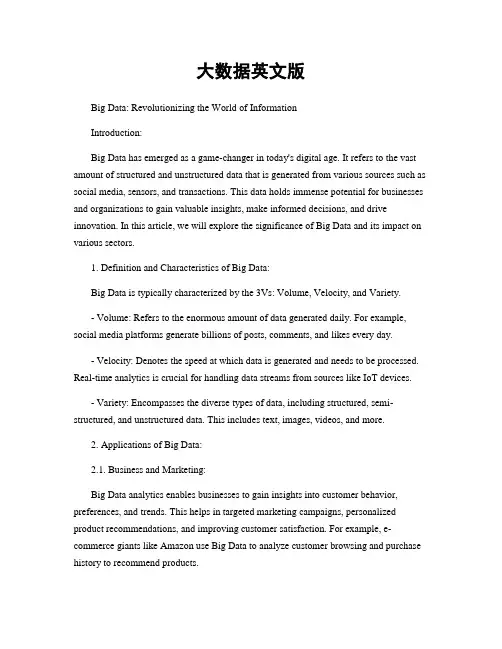
大数据英文版Big Data: Revolutionizing the World of InformationIntroduction:Big Data has emerged as a game-changer in today's digital age. It refers to the vast amount of structured and unstructured data that is generated from various sources such as social media, sensors, and transactions. This data holds immense potential for businesses and organizations to gain valuable insights, make informed decisions, and drive innovation. In this article, we will explore the significance of Big Data and its impact on various sectors.1. Definition and Characteristics of Big Data:Big Data is typically characterized by the 3Vs: Volume, Velocity, and Variety.- Volume: Refers to the enormous amount of data generated daily. For example, social media platforms generate billions of posts, comments, and likes every day.- Velocity: Denotes the speed at which data is generated and needs to be processed. Real-time analytics is crucial for handling data streams from sources like IoT devices.- Variety: Encompasses the diverse types of data, including structured, semi-structured, and unstructured data. This includes text, images, videos, and more.2. Applications of Big Data:2.1. Business and Marketing:Big Data analytics enables businesses to gain insights into customer behavior, preferences, and trends. This helps in targeted marketing campaigns, personalized product recommendations, and improving customer satisfaction. For example, e-commerce giants like Amazon use Big Data to analyze customer browsing and purchase history to recommend products.2.2. Healthcare:Big Data has the potential to revolutionize healthcare by improving patient care, disease prevention, and medical research. By analyzing large volumes of patient data, healthcare providers can identify patterns, predict disease outbreaks, and develop personalized treatment plans. For instance, analyzing genetic data can help in identifying individuals at risk of hereditary diseases.2.3. Finance:Big Data analytics is transforming the finance industry by providing insights for fraud detection, risk assessment, and customer segmentation. Banks and financial institutions can analyze transactional data to detect anomalies and prevent fraudulent activities. Additionally, Big Data helps in assessing creditworthiness and tailoring financial products to customer needs.2.4. Transportation and Logistics:Big Data plays a crucial role in optimizing transportation and logistics operations. By analyzing data from sensors and GPS devices, companies can track and manage their fleet efficiently, reducing fuel consumption and delivery time. Furthermore, analyzing traffic patterns helps in improving route planning and reducing congestion.2.5. Education:Big Data analytics can enhance the education sector by providing insights into student performance, personalized learning, and curriculum development. By analyzing student data, educators can identify areas where students may be struggling and provide targeted interventions. Additionally, Big Data helps in developing adaptive learning platforms that cater to individual student needs.3. Challenges and Opportunities:While Big Data offers immense opportunities, it also poses challenges that need to be addressed:3.1. Data Privacy and Security:As the volume of data increases, ensuring data privacy and security becomes critical. Organizations need to implement robust security measures to protect sensitive information from unauthorized access and cyber threats.3.2. Data Quality and Integration:Big Data comes from various sources and may have inconsistencies, errors, and duplications. Ensuring data quality and integrating data from different sources pose challenges that need to be overcome for accurate analysis and decision-making.3.3. Skill Gap:The field of Big Data requires professionals with expertise in data analytics, machine learning, and programming. Bridging the skill gap and training individuals in these areas is essential for organizations to harness the full potential of Big Data.Conclusion:Big Data has revolutionized the world of information by providing organizations with valuable insights and enabling data-driven decision-making. Its applications span across various sectors, including business, healthcare, finance, transportation, and education. However, challenges such as data privacy, quality, and skill gap need to be addressed to fully leverage the potential of Big Data. As technology continues to advance, Big Data will continue to evolve and shape the future of industries worldwide.。
大数据英文版Big Data: Revolutionizing the WorldIntroduction:In the era of digitalization, data has become the new oil, and harnessing its power has become crucial for businesses and industries worldwide. Big data, a term that refers to the vast amount of structured and unstructured data, is transforming the way we live, work, and make decisions. This article aims to provide a comprehensive overview of big data, its significance, and its impact on various sectors.1. What is Big Data?Big data refers to extremely large and complex data sets that cannot be effectively managed, processed, or analyzed using traditional data processing methods. It encompasses both structured data (e.g., numbers, dates) and unstructured data (e.g., text, images, videos). The three main characteristics of big data are volume, velocity, and variety.2. The Importance of Big Data:2.1 Decision Making and Insights:Big data analytics enables organizations to gain valuable insights from large datasets, facilitating data-driven decision making. By analyzing patterns, trends, and correlations, businesses can optimize operations, identify new opportunities, and predict future trends. For example, a retail company can analyze customer purchasing behavior to personalize marketing campaigns and improve customer satisfaction.2.2 Innovation and Competitive Advantage:Big data fuels innovation by providing organizations with the ability to uncover hidden patterns and relationships. By leveraging big data analytics, companies can develop new products and services that meet customer needs more effectively. Thisenhances their competitive advantage and allows them to stay ahead in the market. For instance, healthcare providers can use big data to develop personalized treatment plans based on patient data, leading to improved healthcare outcomes.2.3 Customer Experience and Personalization:Big data enables organizations to understand their customers better and deliver personalized experiences. By analyzing customer preferences, behavior, and feedback, companies can tailor their offerings to individual needs. This enhances customer satisfaction and loyalty. For example, streaming platforms like Netflix use big data algorithms to recommend personalized content to users based on their viewing history and preferences.3. Impact of Big Data on Various Sectors:3.1 Healthcare:Big data has revolutionized healthcare by improving patient care, disease prevention, and research. Electronic health records, wearable devices, and genetic data contribute to massive amounts of healthcare data. By analyzing this data, healthcare providers can identify disease patterns, predict outbreaks, and develop personalized treatment plans. Moreover, big data analytics can help identify potential drug interactions and adverse effects, enhancing patient safety.3.2 Retail:Big data analytics has transformed the retail industry by enabling personalized marketing, inventory optimization, and demand forecasting. By analyzing customer data, retailers can understand buying behavior, preferences, and trends. This allows them to tailor marketing campaigns, offer personalized recommendations, and optimize pricing strategies. Additionally, big data analytics helps retailers optimize inventory levels, reducing costs and minimizing out-of-stock situations.3.3 Finance:Big data plays a crucial role in the finance sector, enabling fraud detection, risk assessment, and algorithmic trading. By analyzing large volumes of financial data, banks and financial institutions can identify suspicious activities and prevent fraudulent transactions. Big data analytics also helps assess credit risk, predict market trends, and optimize investment strategies. Furthermore, algorithmic trading uses big data analytics to make real-time trading decisions based on market data and patterns.4. Challenges and Considerations:4.1 Privacy and Security:As big data involves the collection and analysis of vast amounts of personal information, privacy and security concerns arise. Organizations must ensure compliance with data protection regulations and implement robust security measures to protect sensitive data from unauthorized access and breaches.4.2 Data Quality and Integration:Ensuring the accuracy, completeness, and consistency of data is essential for reliable analysis and decision making. Data integration from various sources can be challenging due to differences in formats, structures, and quality. Organizations must invest in data cleansing and integration processes to ensure high-quality data for analysis.4.3 Skill Gap:The growing demand for big data analytics professionals has created a skill gap in the industry. Organizations need skilled data scientists, analysts, and engineers who can effectively analyze and interpret big data. Bridging this gap requires investing in training programs and fostering a data-driven culture within organizations.Conclusion:Big data is transforming the world by providing organizations with valuable insights, driving innovation, and enhancing decision-making processes. Its impact spans across various sectors, including healthcare, retail, and finance. However, organizations must address challenges related to privacy, data quality, and skill gaps to fully leverage thepotential of big data. By embracing big data analytics, businesses can gain a competitive edge and thrive in the digital age.。